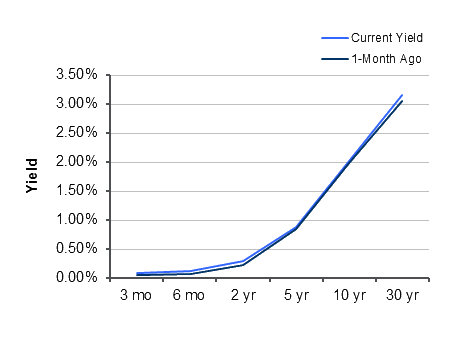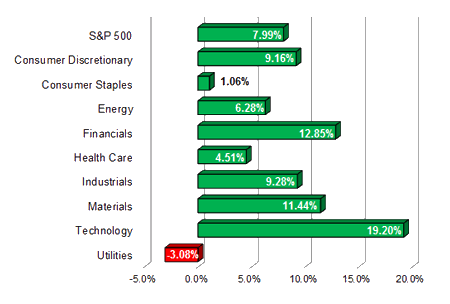
Market Commentary by Scott J. Brown, Ph.D., Chief Economist

The Greek soap opera continued, but investors took some encouragement in the hope that a deal will be soon reached. Bond yields backed up on reduced fear about Europe and on reduced odds of further Fed asset purchases.
The January 24-25 Fed policy meeting minutes showed only “a few” officials leaning toward QE3, although others thought such action would be warranted if “the economy lost momentum or if inflation seemed likely to remain below the (2%) inflation mandate over the medium term.” Fed officials continued to see an unusually high level of uncertainty surrounding the outlooks for growth and unemployment.
The Consumer Price Index rose 0.2% in January (+2.9% year-over-year), up 0.2% ex-food & energy (+2.3% year-over-year). Bear in mind that the Fed’s inflation target gauge, the PCE Price Index, usually runs about 0.2 or 0.3 percentage points below the CPI (hence, core consumer price inflation appears to be right on target on a year-over-year basis).
Retail sales rose a disappointing 0.4% in January, with downward revisions to November and December. Industrial production was flat in January, held down by a weather-related 2.5% drop in the output of utilities (which followed a 2.4% decline in December) –manufacturing output rose 0.8%, following a 1.5% increase in December (+4.7% year-over-year).
Next week, the economic calendar thins out. Home sales figures are likely to see some benefit from an unusually mild winter, which could be exaggerated by the seasonal adjustment. The bond market will face supply (in the form of 2-, 5-, and 7- year notes).
Indices
| Last | Last Week | YTD return % | |
| DJIA | 12904.08 | 12890.46 | 5.62% |
| NASDAQ | 2959.85 | 2927.23 | 13.62% |
| S&P 500 | 1358.04 | 1351.95 | 7.99% |
| MSCI EAFE | 1530.02 | 1549.80 | 8.32% |
| Russell 2000 | 829.96 | 824.99 | 12.02% |
Consumer Money Rates
| Last | 1-year ago | |
| Prime Rate | 3.25 | 3.25 |
| Fed Funds | 0.11 | 0.16 |
| 30-year mortgage | 3.85 | 4.96 |
Currencies
| Last | 1-year ago | |
| Dollars per British Pound | 1.578 | 1.606 |
| Dollars per Euro | 1.310 | 1.355 |
| Japanese Yen per Dollar | 78.940 | 83.710 |
| Canadian Dollars per Dollar | 0.997 | 0.986 |
| Mexican Peso per Dollar | 12.838 | 12.097 |
Commodities
| Last | 1-year ago | |
| Crude Oil | 102.31 | 84.99 |
| Gold | 1722.38 | 1374.77 |
Bond Rates
| Last | 1-month ago | |
| 2-year treasury | 0.29 | 0.23 |
| 10-year treasury | 2.01 | 1.98 |
| 10-year municipal (TEY) | 2.84 | 2.70 |
Treasury Yield Curve – 2/17/2012
S&P Sector Performance (YTD) – 2/17/2012
| February 20th |
— |
President’s Day Holiday (markets closed) |
| February 22nd |
— |
Existing Home Sales (January) |
| February 23rd |
— |
Jobless Claims (week ending February 18th) |
| February 24th |
— |
Consumer Sentiment (February) New Home Sales (January) |
| February 28th |
— |
Durable Goods Orders (January) Consumer Confidence (January) |
| February 29th |
— |
Real GDP (4Q11, 2nd estimate) Bernanke Monetary Policy Testimony (tentative) |
| March 9th |
— |
Employment Report (February) |
| March 13th |
— |
FOMC Policy Decision (no press briefing) |
Important Disclosures
US government bonds and treasury bills are guaranteed by the US government and, if held to maturity, offer a fixed rate of return and guaranteed principal value. US government bonds are issued and guaranteed as to the timely payment of principal and interest by the federal government. Treasury bills are certificates reflecting short-term (less than one year) obligations of the US government.
Commodities trading is generally considered speculative because of the significant potential for investment loss. Markets for commodities are likely to be volatile and there may be sharp price fluctuations even during periods when prices overall are rising. Specific sector investing can be subject to different and greater risks than more diversified investments.
Tax Equiv Muni yields (TEY) assume a 35% tax rate on triple-A rated, tax-exempt insured revenue bonds.
![]() Material prepared by Raymond James for use by its financial advisors.
Material prepared by Raymond James for use by its financial advisors.
The information contained herein has been obtained from sources considered reliable, but we do not guarantee that the foregoing material is accurate or complete. Data source: Bloomberg, as of close of business February 16th, 2012.
©2012 Raymond James Financial Services, Inc. member FINRA / SIPC.




